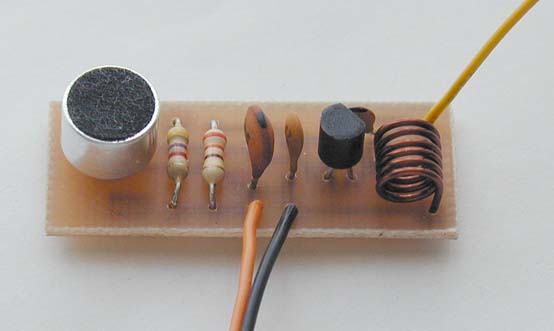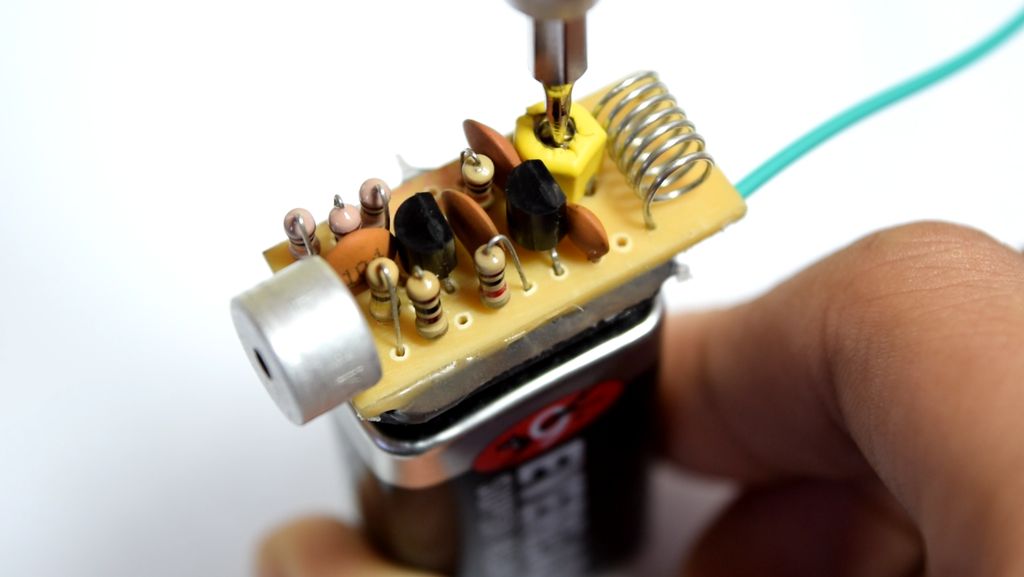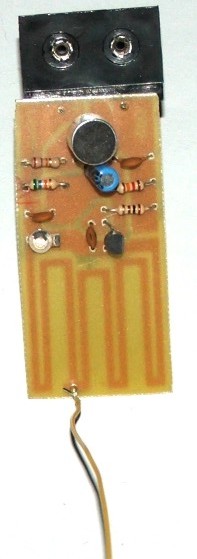|
|
Micro Spy PLL FM Transmitter
This micro spy PLL FM Transmitter transmits on the 160MHz frequency (if we use a 40MHz quartz) and therefore can be listened through a receiver tuned on this frequency. This circuit can be used to on various frequencies, for example on the FM band 88-108 just modifying some components, among which the quartz (25MHz).
Voice is detected by an electret microphone, then it is amplified and filtered by U1 pass-band in order then to be modulated from the carrier section, where through the varicap diode it "mixes" with the frequency generated by the quartz, that guarantees an adapted stability. Practically the modulating voltage is obtained applying the audio signal to the resonating circuit varicap diode that determines the carrier oscillation. The carrier frequency (160 MHz) must be greater than the modulating frequency (300-3300 Hz) audio band.
The transmission is on the fourth harmonic, therefore 160MHz, the oscillation frequency of the driver RF transistor Q1.
A small calibration is allowed acting on the L1 inductance and the C1 Trimmer Capacitor.

Micro Transmitter Bug
Presented FM transmitter bug is built using BF414 / BF324 / BF606 transistor. The 30cm antenna has a range of about 30m in the building, more in the open field. Power supply 2x AAA batteries have been used with voltage of 2.75 V. I added resistor 10K in parallel with 1.5pF capacitor so that the system works well when connected to an external source (mp3 player / computer). On the computer I had to reduce sound to about 35% of capacity, so that I do not have clipping. I managed to improve transmitter stability with simple shielding. The coil is 5 turns of enameled copper wire wound on 1 mm ø = 5 mm.

Mini FM Broadcast Transmitter
Build your own simple mini FM transmitter. This fun project will show you how to build a mini broadcasting transmitter that can transmit an audio signal up to a quarter mile to any FM receiver. It's easy to build and a good learning experience. It serves as a hands-on learning tool for students or anybody interested in electronics. Having a range of up to a quarter mile, it's great for a house security system, baby monitoring device or simply a listening gadget that you can place anywhere!

Mini FM Radio Broadcast Transmitter
Have you ever wanted to broadcast your own radio station within your neighborhood? This small and simple 87-108MHz FM transmitter is the toy that geeks have always wanted. This tutorial includes the PCB layout and the schematics. It has a range of up to 1/4 mile or more. It's great for room monitoring, baby listening and nature research.

Mini FM Radio Transmitter
This small FM transmitter with a range of about 50 meters designed for hoby. With lots of mini-transmitters then you have a comprehensive, action-packed radio program. Due to the power supply via the USB port of a high frequency stability is achieved. Alternatively, the receiver, a battery 5 to 12 volts to operate.

Mini FM Transmitter
9 Volt battery operated simple Mini FM Transmitter. FM Transmitter is very simple, compact, and has transmission signal with a range of 100-150m, good sensitivity and low current consumption. Transmitter's schematic consists of a bass amplifier for the first transistor and the proper frequency generator in the second. FM Transmitter divided transitional capacitor that allows you to set up a cascade separately.

Mini FM Transmitter
Here's how to build your own mini FM transmitter. It transmits FM waves so you could easily receive the signals on your mobile phone, radios, etc. As the name and the picture indicates it is very small and is approximately the size of a 9v battery clip. With this FM transmitter you could start your own mini FM station. The circuit uses BC547 transistor to amplify the signal and then frequency modulate it. It uses "frequency modulation" most commonly known as FM, the same principal to transmit audio signals captured by the microphone.

Miniature FM Transmitter
This miniature transmitter is easy to construct and it's transmissions can be picked up on any standard FM receiver. It has a range of up to 1/4 of a mile or more. It is great for room monitoring, baby listening, nature research, etc. L1 is 8 to 10 turns of 22 gauge hookup wire close wound around a non-conductive 1/4 inch diameter form, such as a pencil. C4 is a small, screw-adjustable, trimmer capacitor. Set your FM receiver for a clear, blank space in the lower end of the band. Then, with a non-conductive tool, adjust this capacitor for the clearest reception. A little experimenting and patience may be in order. Most of the parts' values are not critical, so you can try adjusting them to see what happens.

One Transistor FM Transmitter
This circuit is basically an oscillator which runs at around 100 MHz. The most important parts of the oscillator are the transistor Q1 and the tuned circuit, which comprises the inductor Ll and the variable capacitor CV1. When the battery is first connected, a brief surge of current flows from the collector to the emitter of Q1, causing an oscillating (i.e: alternating) current to flow back and forth between Ll and CV1. An oscillating voltage therefore appears at the junction of Ll and CV1. The frequency of the oscillation depends on the values of Ll and CV1, so that varying the value of CV1 tunes the oscillations to the exact frequency required.

Pen FM Transmitter Bug
Pen FM Transmitter bug projects have been very popular. The idea of being able to hide a transmitter in a pen is very appealing. In an effort to reduce the size of this design, we have used surface-mount components. Firstly, the thought of using the coil in the tank circuit for transmitting RF was a little far fetched, but we used it as an example for those who were interested in experimenting with our circuits. Now we have gone back to a conventional antenna, the whip. The whip or straight-line antenna can be coiled, wound longitudinally or folded. The way it is wound makes a big difference to its effectiveness, but when you are limited in space, you have to accept these limitations.
Even though we have used this antenna set up in our previous pen bugs we have considerably improved the circuit to the point were it has low battery consumption, but high RF output. The size of this design has been reduced considerably by using surface-mount components.

|
|
|
| |
Accurate LC Meter
Build your own Accurate LC Meter (Capacitance Inductance Meter) and start making your own coils and inductors. This LC Meter allows to measure incredibly small inductances making it perfect tool for making all types of RF coils and inductors. LC Meter can measure inductances starting from 10nH - 1000nH, 1uH - 1000uH, 1mH - 100mH and capacitances from 0.1pF up to 900nF. The circuit includes an auto ranging as well as reset switch and produces very accurate and stable readings. |
|
PIC Volt Ampere Meter
Volt Ampere Meter measures voltage of 0-70V or 0-500V with 100mV resolution and current consumption 0-10A or more with 10mA resolution. The meter is a perfect addition to any power supply, battery chargers and other electronic projects where voltage and current must be monitored. The meter uses PIC16F876A microcontroller with 16x2 backlighted LCD. |
|
|
|
60MHz Frequency Meter / Counter
Frequency Meter / Counter measures frequency from 10Hz to 60MHz with 10Hz resolution. It is a very useful bench test equipment for testing and finding out the frequency of various devices with unknown frequency such as oscillators, radio receivers, transmitters, function generators, crystals, etc. |
|
1Hz - 2MHz XR2206 Function Generator
1Hz - 2MHz XR2206 Function Generator produces high quality sine, square and triangle waveforms of high-stability and accuracy. The output waveforms can be both amplitude and frequency modulated. Output of 1Hz - 2MHz XR2206 Function Generator can be connected directly to 60MHz Counter for setting precise frequency output. |
|
|
|
BA1404 HI-FI Stereo FM Transmitter
Be "On Air" with your own radio station! BA1404 HI-FI Stereo FM Transmitter broadcasts high quality stereo signal in 88MHz - 108MHz FM band. It can be connected to any type of stereo audio source such as iPod, Computer, Laptop, CD Player, Walkman, Television, Satellite Receiver, Tape Deck or other stereo system to transmit stereo sound with excellent clarity throughout your home, office, yard or camp ground. |
|
USB IO Board
USB IO Board is a tiny spectacular little development board / parallel port replacement featuring PIC18F2455/PIC18F2550 microcontroller. USB IO Board is compatible with Windows / Mac OSX / Linux computers. When attached to Windows IO board will show up as RS232 COM port. You can control 16 individual microcontroller I/O pins by sending simple serial commands. USB IO Board is self-powered by USB port and can provide up to 500mA for electronic projects. USB IO Board is breadboard compatible. |
|
|
|
|
ESR Meter / Capacitance / Inductance / Transistor Tester Kit
ESR Meter kit is an amazing multimeter that measures ESR values, capacitance (100pF - 20,000uF), inductance, resistance (0.1 Ohm - 20 MOhm), tests many different types of transistors such as NPN, PNP, FETs, MOSFETs, Thyristors, SCRs, Triacs and many types of diodes. It also analyzes transistor's characteristics such as voltage and gain. It is an irreplaceable tool for troubleshooting and repairing electronic equipment by determining performance and health of electrolytic capacitors. Unlike other ESR Meters that only measure ESR value this one measures capacitor's ESR value as well as its capacitance all at the same time. |
|
Audiophile Headphone Amplifier Kit
Audiophile headphone amplifier kit includes high quality audio grade components such as Burr Brown OPA2134 opamp, ALPS volume control potentiometer, Ti TLE2426 rail splitter, Ultra-Low ESR 220uF/25V Panasonic FM filtering capacitors, High quality WIMA input and decoupling capacitors and Vishay Dale resistors. 8-DIP machined IC socket allows to swap OPA2134 with many other dual opamp chips such as OPA2132, OPA2227, OPA2228, dual OPA132, OPA627, etc. Headphone amplifier is small enough to fit in Altoids tin box, and thanks to low power consumption may be supplied from a single 9V battery. |
|
|
|
|
|
Arduino Prototype Kit
Arduino Prototype is a spectacular development board fully compatible with Arduino Pro. It's breadboard compatible so it can be plugged into a breadboard for quick prototyping, and it has VCC & GND power pins available on both sides of PCB. It's small, power efficient, yet customizable through onboard 2 x 7 perfboard that can be used for connecting various sensors and connectors. Arduino Prototype uses all standard through-hole components for easy construction, two of which are hidden underneath IC socket. Board features 28-PIN DIP IC socket, user replaceable ATmega328 microcontroller flashed with Arduino bootloader, 16MHz crystal resonator and a reset switch. It has 14 digital input/output pins (0-13) of which 6 can be used as PWM outputs and 6 analog inputs (A0-A5). Arduino sketches are uploaded through any USB-Serial adapter connected to 6-PIN ICSP female header. Board is supplied by 2-5V voltage and may be powered by a battery such as Lithium Ion cell, two AA cells, external power supply or USB power adapter. |
|
200m 4-Channel 433MHz Wireless RF Remote Control
Having the ability to control various appliances inside or outside of your house wirelessly is a huge convenience, and can make your life much easier and fun. RF remote control provides long range of up to 200m / 650ft and can find many uses for controlling different devices, and it works even through the walls. You can control lights, fans, AC system, computer, printer, amplifier, robots, garage door, security systems, motor-driven curtains, motorized window blinds, door locks, sprinklers, motorized projection screens and anything else you can think of. |
|
|
|
|